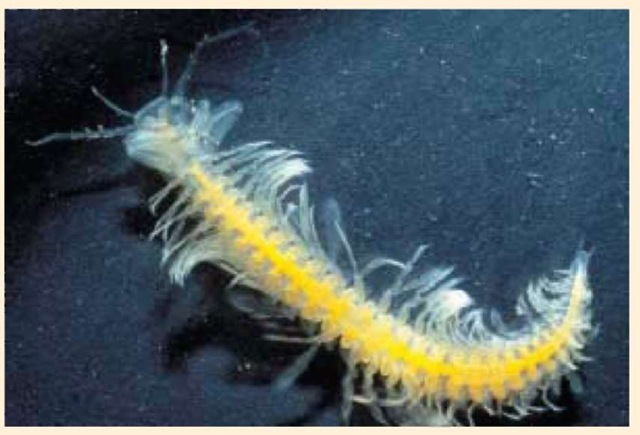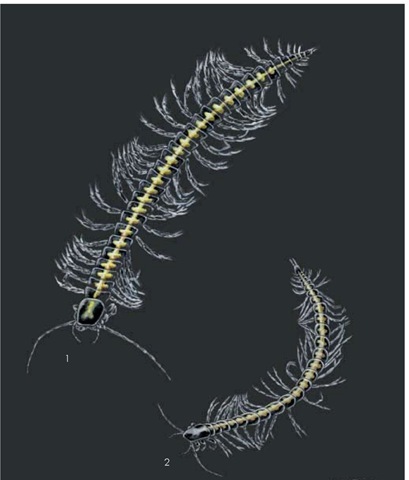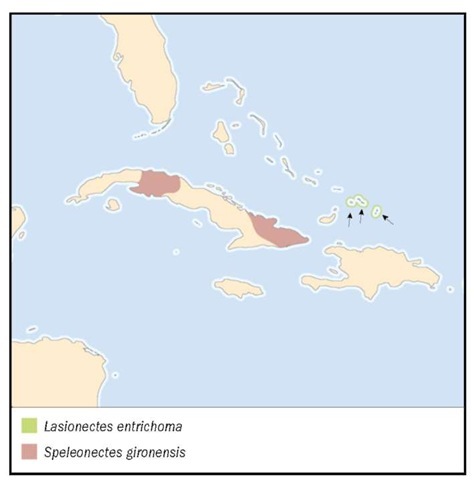Remipedia
(Remipedes)
Phylum Arthropoda
Subphylum Crustacea
Number of families 2
Thumbnail description
Small, marine, cave-dwelling crustaceans characterized by a short head and a long trunk bearing setose swimming appendages.
Photo: An individual of the species Lasionectes entrichoma from the Turks and Caicos Islands.

Evolution and systematics
The class Remipedia has two families, six genera, and 12 described species. At least three more species are undescribed. A single extinct species from a Carboniferous fossil has been placed in the class Remipedia.
Physical characteristics
Remipedes are troglobitic (cave-dwelling) crustaceans, lacking pigmentation and eyes. They are free-swimming and characterized by a short head and an elongate, segmented trunk. The head is covered with a cephalic shield. With the exception of the posterior-most segment(s), each trunk segment bears biramous, paddle-like, setose swimming appendages. Trunk segment number differs in each species. For example, the smallest species has no more than 16 segments as an adult; the largest has 29. Head appendages consist of a pair of small frontal filaments, long first antennae, and small paddle-like second antennae. The base of antenna 1 bears clusters of long aesthetascs for chemosensation. The setae of antenna 2 are long and plumose. The mandibles have a broad molar surface and cusped incisor processes. The first maxillae bear a terminal fang. The second maxillae and maxillipeds are nearly identical, and bear a terminal claw complex. These three feeding appendages are robust and prehensile. The largest species, Godzillius robustus, is about 1.8 in (45 mm) and the smallest, Godzilliognomus frondosus, is about 0.35 in (9 mm) in length.
Distribution
Remipedes are currently known from anchialine caves in most of the major islands of the Bahamas, several islands of the Turks and Caicos, the island of Cozumel, Mexico, Hol-guin and Matanzas Provinces, Cuba, and the island of Lan-zarote in the Canary Islands. They are also known from continental coastal caves in the state of Quintana Roo, Mexico, and in Western Australia.
Habitat
Remipedes live exclusively in submerged caves (anchialine caves) found near the sea on islands or along the coast. An-chialine caves are caves that have surface openings on land and subsurface connections to the sea. This habitat is accessible only by trained cave divers using special scuba techniques and equipment. Anchialine caves typically have a fresh or brackish layer of water overlying deeper marine water. The density interface or halocline also delineates differences in temperature, pH, and dissolved oxygen. Remipedes live in the dark, beneath the density interface in waters that are low in dissolved oxygen. They live in an ecosystem that includes other troglobitic crustaceans, most commonly thermosbae-naceans, cirolanid isopods, caridean shrimp, and amphipods. Blind cave fish are occasionally found in the cave systems where remipedes live. With the exception of one Mexican cave system, all known locations of remipedes contain very few individuals. Most species are quite rare, and fewer than 10 individuals can be observed during a typical cave dive.
Behavior
Remipedes are typically observed swimming in the water column in most caves. However, in one cave in Mexico the remipedes are more frequently swimming along the surface of the sediment. Some of these remipedes have been observed

An individual of the species Speleonectesgironensis from Cuba.
resting motionless on the sediment and sometimes grooming. Several types of grooming behavior have been observed. The first antenna is flicked posteriorly and run along the setae of the swimming appendages. Circle grooming involves a remi-pede curling into a circle and cleaning trunk appendages with the feeding appendages.
Feeding ecology and diet
In their natural habitat remipedes have been observed feeding on cave shrimp and on blind cave fish. In laboratory experiments they will capture, subdue, and eat cave shrimp. Additionally they will eat non-native food items such as brine shrimp and bloodworms. They use the fang of the first maxilla to inject a secretory product into their prey that immobilizes and kills it. The fang is connected by a duct to a large secretory gland. The secretory product remains unanalyzed. Remipedes have a close association with the sediment in some caves. In captivity they have been observed to gather sediment into a small bolus, hold it over their mouth, and ingest material. Some scientists believe that they are using bacteria found in the sediment as either a food source or for some physiological purpose.
Reproductive biology
Remipedes are simultaneous hermaphrodites. The ovary originates in the head, and the oviducts extend to the base of the seventh swimming appendage where the female gonopore is found. The testes originate in the segment of the seventh swimming appendage, and the vas deferens extends to the fourteenth swimming appendage where the male gonopore is located. Sperm is flagellated and packaged into spermatophores. To date, nothing is known about remipede development. Tiny juveniles have been collected. Resembling adults, they are about one-third the length of adults and have at least 14 swimming appendages.
Conservation status
No remipedes are listed by the IUCN. One species, Speleonectes lucayensis, is protected by Lucayan National Park on Grand Bahama Island. Worldwide, anchialine caves are threatened ecosystems. Dangers include deforestation and development above or near the cave systems, use of biocides, improper sewage disposal, and destruction of nearby mangroves. The many caves along the coast of Quintana Roo, Mexico, are in imminent danger due to rapid development of tourist hotels, expansion of cities, and lack of enforcement of environmental laws. Most caves are formed in limestone, which is porous. Any kind of pollutant on the surface can eventually end up in the aquifer. One cave in Quintana Roo is home to thousands of remipedes, a number never recorded anywhere else in the world. This cave is in the path of development.
Significance to humans
Remipedes have no known commercial significance.

1. Lasionectes entrichoma; 2. Speleonectes gironensis.
Species accounts
No common name
Lasionectes entrichoma
ORDER
Nectiopoda
FAMILY
Speleonectidae
TAXONOMY
Lasionectes entrichoma
OTHER COMMON NAMES
None known.
PHYSICAL CHARACTERISTICS
Maximum length is 1.26 in (32 mm); maximum number of trunk segments is 32. The second maxillae and maxillipeds are robust and have thick rows of uniform short setae along the medial margins.
DISTRIBUTION
Anchialine caves of the Turks and Caicos Islands.
HABITAT
Found beneath the halocline from 16 ft (5 m) to deeper depths.
BEHAVIOR
Lasionectids swim in the water column.

FEEDING ECOLOGY AND DIET
Main diet is the caridean shrimp Typhlatya garciai Chace.
REPRODUCTIVE BIOLOGY
Hermaphroditic. Nothing is known about reproductive behavior.
CONSERVATION STATUS
Not listed by the IUCN.
SIGNIFICANCE TO HUMANS
None known.
No common name
Speleonectes gironensis
ORDER
Nectiopoda
FAMILY
Speleonectidae
TAXONOMY
Speleonectes gironensis
OTHER COMMON NAMES
None known.
PHYSICAL CHARACTERISTICS
Maximum length is 0.55 in (14 mm). Maximum number of trunk segments is 25. First maxillae are robust. The caudal rami are at least two times the length of the anal segment.
DISTRIBUTION
Anchialine caves of Matanzas and Holguin Provinces, Cuba.
HABITAT
Found beneath the halocline from 39 ft (12 m) to deeper depths.
BEHAVIOR
Speleonectids swim in the water column.
FEEDING ECOLOGY AND DIET
Their main diet consists of small cave crustaceans.
REPRODUCTIVE BIOLOGY
Hermaphroditic. Nothing is known about reproductive behavior.
CONSERVATION STATUS
Not listed by the IUCN.
SIGNIFICANCE TO HUMANS
None known.
